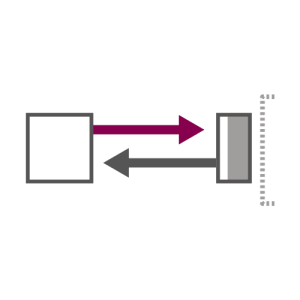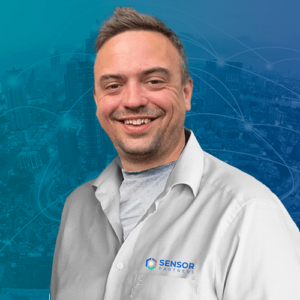What are photoelectric or optical sensors?
Photoelectric sensors are sensors that perceive a change in light intensity . This means a detection (or non-detection) of the light that is sent out by the sensor. The detection method varies per type of photoelectric sensor. The sensor consists of:
- The transmitter, this is the light source (LED);
- The receiver (phototransistor);
- Signal converter;
- Amplifier;
The receiver checks whether the incoming light is coming from the transmitter. Based upon this, the sensor switches or not. Photoelectric sensors are available in different shapes and sizes. This makes these sensors suitable in many industrial applications. There are 4 main groups within photoelectric sensors. Read more about it below.
Photoelectric through-beam sensors
Photoelectric sensors with a separate transmitter and receiver are placed facing each other. This is also called a thru-bream configuration. When an object obstructs the light beams, the output will switch. Thru-beam photoelectric sensors can be found in all sorts of applications. Specifically these with buildup of dirt, liquids and moist or other challenging factors such as ambient lighting. The reason for this is the fact that thru-beam sensors are very reliable, even in challenging applications, such as rollercoasters.
Telco transmitter and receiver photoelectric sensors are so powerful that they can bridge an operating range of 70 meters. A Telco thru-beam sensor is therefore very suitable for use in the most demanding or dirty environments. When a separate transmitter/receiver is used in combination with a separate amplifier, more functions are possible. Such as: multiple output, filtering and timeout or alarm functions. An additional advantage is that 30 thru-beam sensors can be used next to each other without the sensors interfering.

Photoelectric diffuse proximity sensors

Diffuse proximity photoelectric sensors are sensors that detect an object diffusely. These sensors consist of a transmitter or receiver in same housing. No separate receiver, reflector or taught background is used in detections.
A diffuse proximity sensor has various names in the market, such as diffuse proximity switch, proximity switch or reflex sensor. The principle of the photoelectric diffuse proximity sensor is based on object reflection and the transmitter and receiver are positioned side by side in the housing.
The most used proximity sensor is the SMP 8501 MG J. It has a range of 1 meter. The strongest photoelectric diffuse proximity sensor is the SMP 2605 J. The maximum range of this photoelectric sensor is 5 meters and the switching frequency 250 Hz.
Background suppression
Photoelectric sensors with a background suppression function as a photoelectric sensor with diffuse proximity or reflex barriers, with an additional function. These sensors only detect objects within a defined zone. The sensor detects everything that passes between the sensor and the taught background. Ideal for use if you have, for example:
- A blackened baking tray, to be detected
- Want to detect a stainless steel tray in a rusty environment;
- To detect the presence or absence of a product in an environment of glass.
Technically, the background is used optimally. By learning (teach) the sensor on the background, it sees everything that passes before.

The most used background suppression sensor is the: SPBS 2602T J. This sensor has an extra feature with which an increase and/or delay can be set.
Telco transmitter and receiver photoelectric sensors are so powerful that they can bridge an operating range of 70 meters. A Telco thru-beam sensor is therefore very suitable for use in the most demanding or dirty environments. When a separate transmitter/receiver is used in combination with a separate amplifier, more functions are possible. Such as: multiple output, filtering and timeout or alarm functions. An additional advantage is that 30 thru-beam sensors can be used next to each other without the sensors interfering.
Photoelectric retro-reflective & polarized sensors

With retro-reflective photoelectric sensors, or photoelectric sensors with a reflector, the transmitter and receiver are in one housing. However, the sensor always looks at a reflector instead of an object. The reflector is placed directly opposite of the photoelectric sensor. When the light beam is interrupted, the sensor switches.
Telco's photoelectric sensors with reflector can be designed as polarized or retro-reflective (non-polarized) sensors.
- Polarized sensors are equipped with a special polarizing filter, so that the receiver only accepts light reflected from the polarized reflector. This way it is prevented that switching takes place, for example by someone with reflective clothing. But also the metallic paint of a car or bare metal are examples of this. The polarizing filter can also detect transparent and reflective objects such as glass or plastic packaging.
- A retro-reflective reflector reflects the received light exactly as it is received. Regardless of the angle. The light beam from the transmitter of a retro-reflective sensor is therefore reflected directly via the reflector to the receiver of the sensor. When the light beam is intercepted by an object, a switching occurs.
The most used polarized retro-reflective photoelectric sensor is the SPPR 2610T J. For a retro-reflective sensor this is the: SMRR 8500 MG J.






